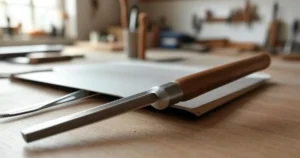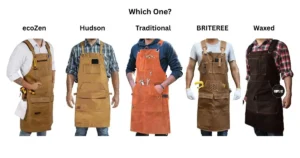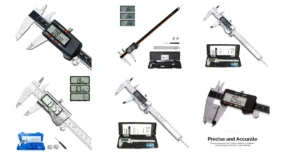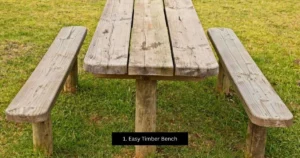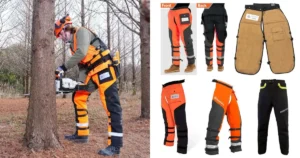Awls are vital tools in woodworking, leatherworking, and other crafts. They’ve been used since ancient times, evolving from bone and stone to modern steel designs. This guide explores 9 types of awls, their applications, and how to choose the right one.
Table of Contents
What Are Awls?
What is an awl? An awl is a sharp tool for marking or piercing wood, leather, and other materials in crafting. Typically featuring a steel tip and a handle (wood, plastic, or brass), awls ensure precision in tasks like marking wood for cuts, piercing leather for stitching, or creating starter holes for screws.
What is an awl also known as? Awls are sometimes called bradawls (in woodworking), stitching awls (in leatherworking), or prickers, depending on their specific use.
Why Use an Awl?
Awls provide unmatched accuracy for marking and piercing, preventing material damage (e.g., wood splitting) and ensuring clean, professional results. They’re essential for tasks requiring exact measurements or strong seams, such as crafting leather goods or assembling furniture.
What is an Awl Tool Used for in Sewing?
Types of Awls and Their Uses
Below is a detailed overview of nine common awl types, their descriptions, and primary uses.
| Awl Type | Primary Use | Best For |
| Scratch Awl | Marking lines, creating pilot holes | Woodworking |
| Stitching Awl | Punching holes for sewing | Leatherworking, canvas work |
| Brad Awl | Creating pilot holes for fasteners | Woodworking |
| Hole Punch Awl | Making larger holes for rivets, laces | Leatherworking |
| Palm Awl | Heavy-duty piercing with palm control | Thick leather projects |
| Diamond Awl | Precise stitching holes | High-end leathercraft |
| Leather Awl | General piercing, marking in leather | Leatherworking |
| Wood Awl | Marking, piercing in wood | Woodworking |
| Tapered Awl | Versatile hole creation | Wood and leather projects |
Types of Awls and Their Uses
Below are nine types of awls, each optimized for specific tasks. Each section is designed for Google featured snippets and voice search, with short sentences and clear answers.
1. Scratch Awl
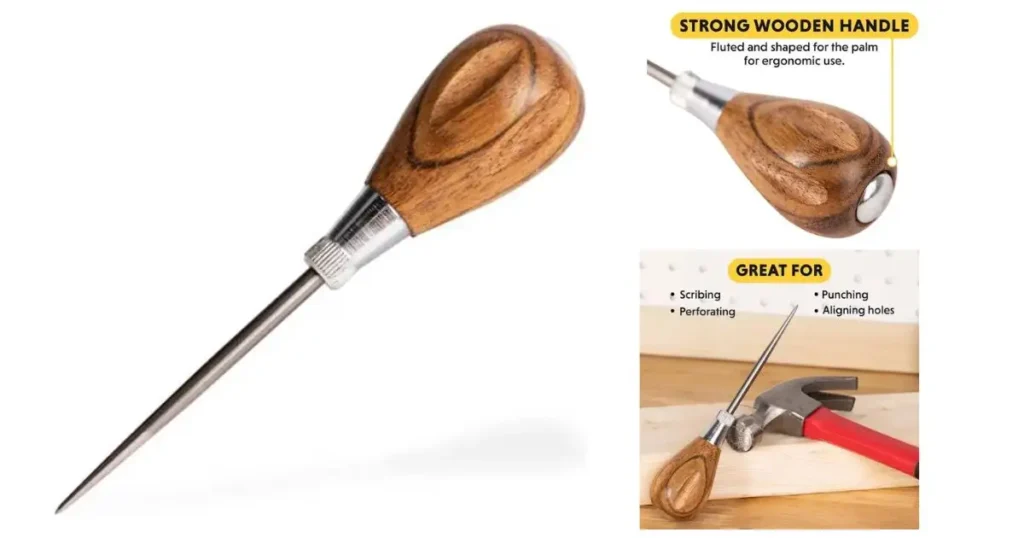
What is a scratch awl? A scratch awl is a woodworking tool with a sharp steel spike and a handle, used to scribe lines or mark points. It creates shallow grooves for precise cutting or indentations for drilling. Its versatility extends to leather crafting and sheet metal work. The handle, often wood or plastic, ensures a firm grip and prevents rolling.
Uses:
- Scribes lines on wood for sawing or chiseling.
- Marks points for drilling or screw placement.
- Pierces small holes in leather or soft materials.
- Traces patterns in leather crafting.
- Punches holes or scribbles lines in sheet metal.
Construction: The sharp tip ensures precision, while a reinforced shank adds strength. Handles are ergonomic for comfort.
Safety: Handle the ice-pick-like tip carefully to avoid injury. Store in a sheath to protect the tip.
Tips: Use light pressure for shallow marks. Priced at $5-$15, it’s beginner-friendly. Limitation: Not suited for hard metals.
Can you use an awl on metal? Yes, a scratch awl can mark or punch holes in soft metals like aluminum or thin sheet metal, but it’s not designed for hard metals.
How to use Scratch Awls? Check this video.
Learn More: Scratch Awl Uses
2. Stitching Awl
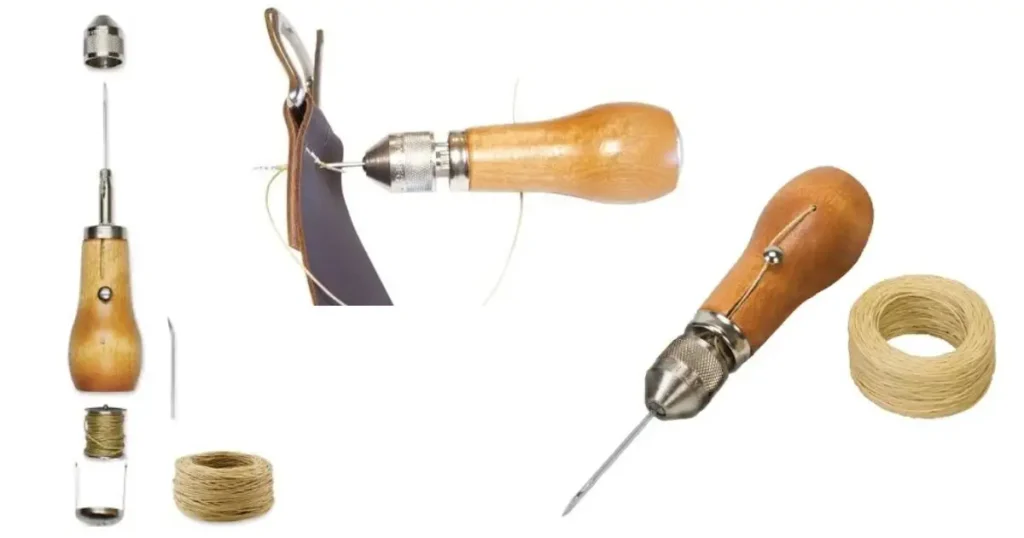
What is a stitching awl? Like the Speedy Stitcher sewing awl, a stitching awl pierces leather for hand-stitching. It features a needle-like tip and an ergonomic handle, often with an eye for threading. It’s ideal for creating durable stitches in leather or canvas.
Uses:
- Creates evenly spaced holes for leather stitching.
- Repair shoes, bags, or upholstery with a leather stitching awl kit.
- Supports hand stitching with sewing awl needles and thread.
Construction: Includes a steel needle and a handle, often with interchangeable straight or curved needles. Kits like the Speedy Stitcher include thread and instructions.
Safety: Keep the sharp needle away from children. Use a stable surface to prevent slipping.
Tips: Thread before piercing for efficiency. Priced at $20-$40, it’s great for DIY. Limitation: Not ideal for very thick leather; use a palm awl instead.
What is a caning awl used for? A caning awl, a type of stitching awl, is used to weave or repair chair cane, creating holes for cane strips in furniture restoration.
How to use the stitching AWL. Check this video:
Learn More: Stitching Awls
3. Brad Awl
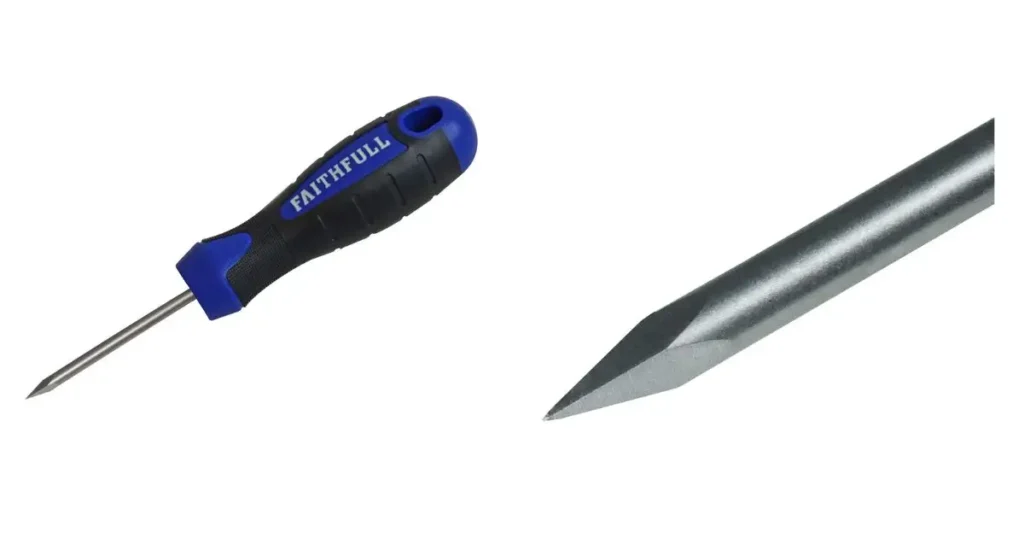
Also known as a bradawl, this woodworking tool has a flat, chisel-like tip that cuts through wood fibers to create small pilot holes for nails or screws (Bradawl).
By twisting the tool, it displaces wood fibers, preventing splitting and ensuring secure fastener placement. It’s ideal for delicate woodworking tasks requiring precision.
Uses:
- Pre-drill holes for fasteners in carpentry.
- Ensures precise placement for screws or nails.
- Reduces splitting in delicate wood projects.
Construction: Features a flat, chisel-like steel tip and a wooden or plastic handle for control.
Safety: Apply controlled pressure to avoid slipping. Store with a protective cover.
Tips: Twist to cut clean holes. Priced at $10-$20, it’s ideal for cabinetry. Limitation: Limited to small holes; use a drill for larger ones.
What is the difference between an awl and a bradawl? A general awl is a broad term for piercing tools, while a bradawl specifically has a chisel-like tip for woodworking pilot holes.
Learn More: Brad Awls
4. Hole Punch Awl
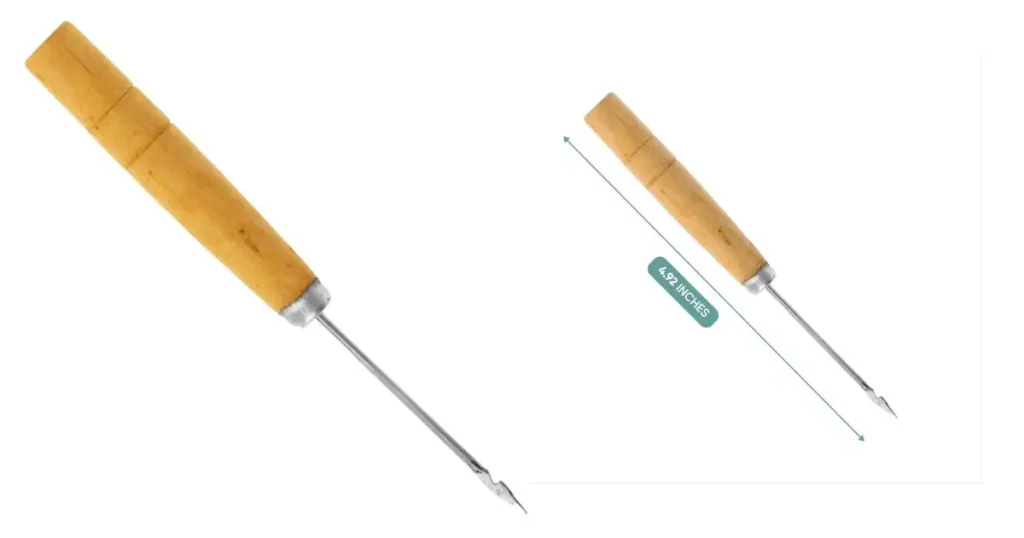
A hole punch awl is a robust tool for creating larger holes in leather or other thick materials, suitable for rivets, laces, or decorative elements. Unlike stitching awls, which focus on fine sewing holes, hole punch awls are built for heavier-duty applications, offering the strength needed to penetrate tough materials.
Uses:
- Punches holes for rivets, laces, or decorative elements.
- Used in bookbinding for piercing paper or boards.
- Handles tough materials with durability.
Construction: Features a sturdy steel tip and a comfortable handle, often bulb-shaped for grip.
Safety: Wear gloves to protect your hands. Use a cutting mat to prevent damage.
Tips: Match the tip size to the rivets. Priced at $15-$30, it’s vital for bookbinding. Limitation: Not for fine stitching; use a stitching awl.
Learn More: Hole Punch Awls
5. Palm Awl
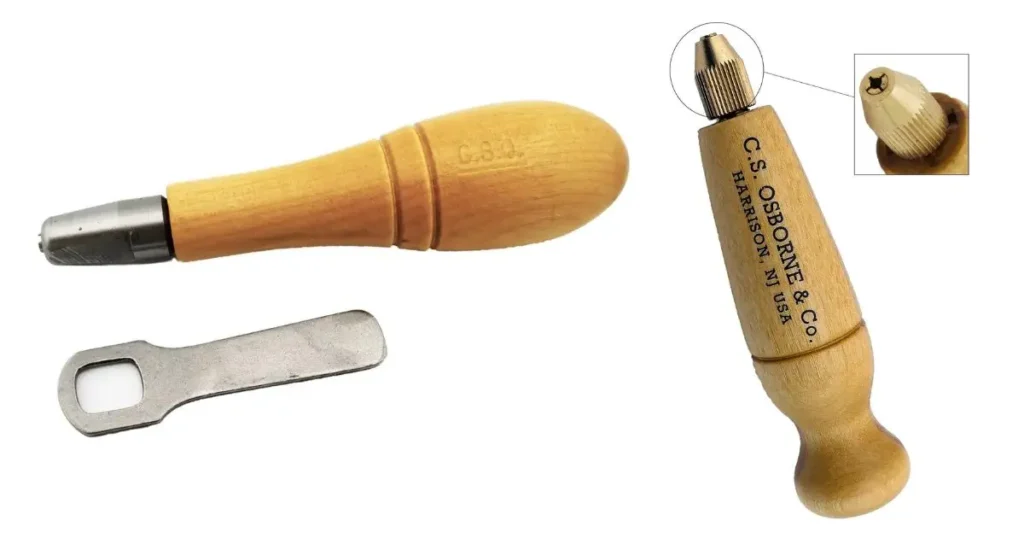
A palm awl features a compact, bulbous handle that fits in the palm, providing enhanced control and leverage for heavy-duty leatherworking tasks (Stitching Awl Kit). It’s ideal for piercing thick leather, such as in knife sheath or belt production, where significant force is required. Its ergonomic design minimizes hand fatigue.
Uses:
- Pierces 8-9 oz leather for knife sheaths or belts.
- Creates precise stitch slits in leather crafting.
- Handles projects needing significant force.
Construction: Features a sharp steel blade and a bulbous handle for grip. Some have interchangeable blades.
Safety: Maintain a firm grip to prevent slipping. Store with a protective cap.
Tips: Use on a stable surface. Priced at $20-$40, it’s professional-grade. Limitation: Bulky for small projects; use a leather awl instead.
Learn More: Palm Awls
6. Diamond Awl
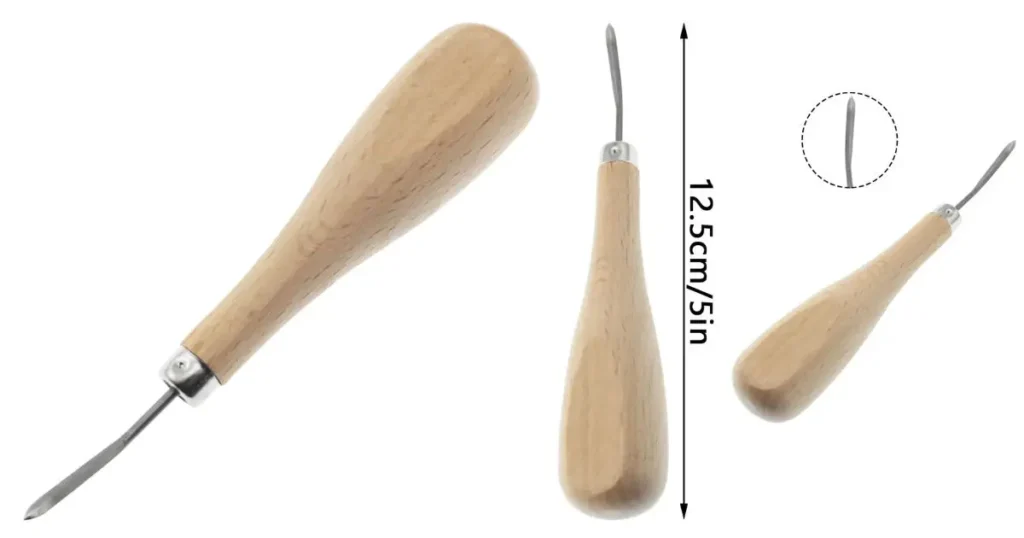
The diamond awl, with its diamond-shaped tip, is tailored for creating precise, angled stitching holes in leather, ensuring tight, professional seams (Types of Leather Awls). It is popular for high-end leathercraft, particularly luxury handbags, because it maintains stitch alignment effectively.
Uses:
- Creates angled holes for saddle stitching.
- Ensures consistent stitches for professional leatherwork.
- Ideal for luxury bags or belts.
Construction: Features a rhomboid steel blade and a wooden handle with a ferrule.
Safety: Sharpen evenly to maintain shape. Store safely to avoid injury.
Tips: Match the blade size to the pricking iron. Priced at $20-$50, it’s for professionals. Limitation: Not for threading; use a stitching awl.
Learn More: Diamond Awls
7. Leather Awl
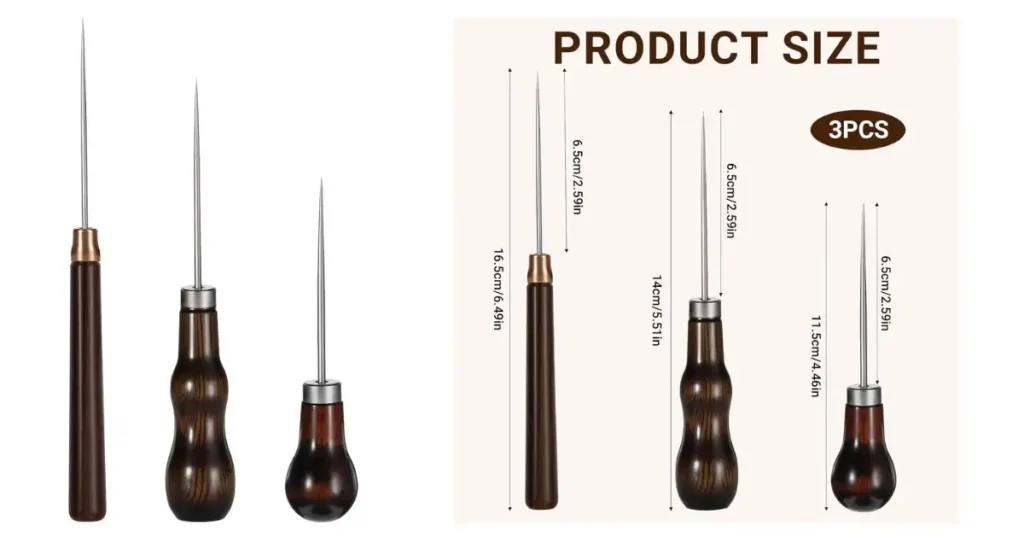
Leather awls are a broad category of tools optimized for leatherworking, used for piercing, stitching, or marking leather (Leather Awl). Available in various tip shapes and sizes, they cater to diverse project needs, from fine stitching to pattern tracing.
Uses:
- Pierces holes for stitching bags or shoes.
- Marks patterns on leather, cloth, or wood.
- Supports DIY repairs with a leather sewing awl kit.
Construction: Features a steel tip and a brass or wooden handle.
Safety: Clean to prevent rust. Store away from children.
Tips: Choose a needle size for leather thickness. Priced at $15-$35, it’s beginner-friendly. Limitation: Less precise for fine stitching; a diamond awl.
Can I use a leather awl for woodworking? Yes, leather awls can mark soft wood, but scratch or brad awls are better for precision and durability in woodworking.
Learn More: Leather Awls
8. Wood Awl
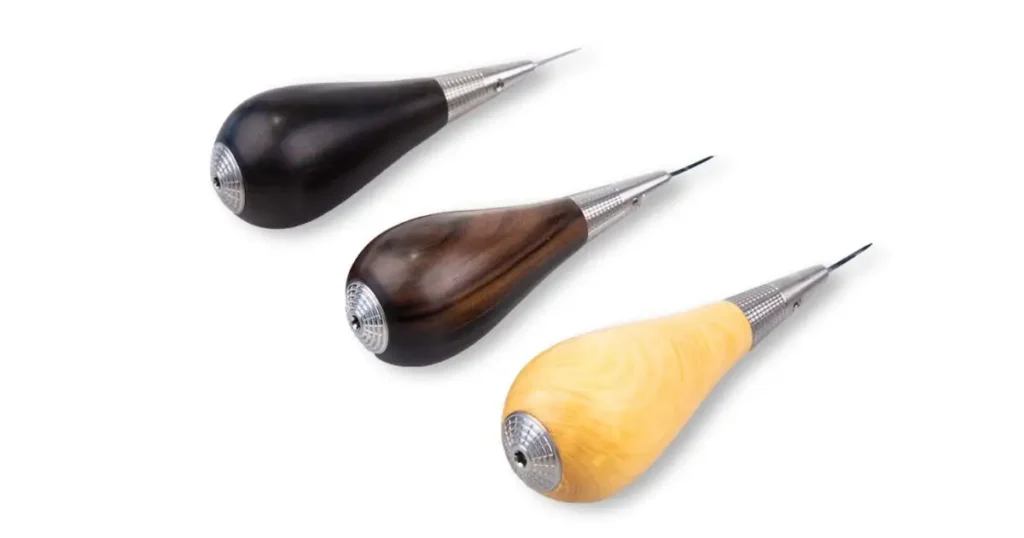
Wood awls are designed for woodworking, overlapping with scratch and brad awls in function. They are used for marking lines, creating pilot holes, or light piercing, ensuring accuracy in cutting and fastening (Types of Awls). They are essential for meticulous woodworking projects.
Uses:
- Mark the wood for cutting or drilling.
- Creates pilot holes to prevent splitting.
- Scribes lines on wood or laminates.
Construction: Features a sharp steel tip and a comfortable handle, often with a plastic sleeve.
Safety: Use a sleeve to protect the tip. Handle carefully to avoid injury.
Tips: Use fine points for softwoods, sturdier for hardwoods. Priced at $10-$20, it’s essential. Limitation: Not for thick leather; use a palm awl.
Learn More: Best Wood Awls
9. Tapered Awl
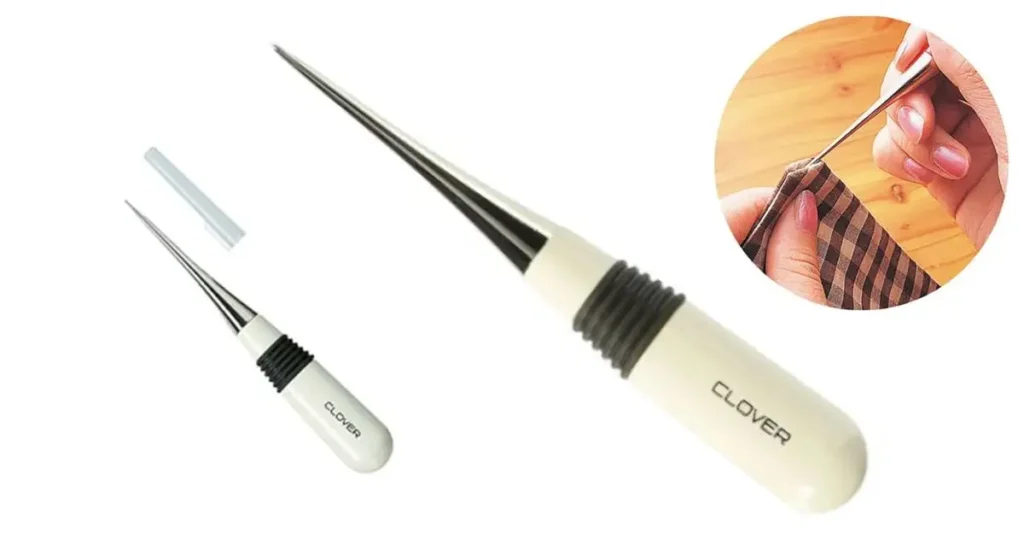
A tapered awl has a gradually narrowing tip, allowing for versatile hole creation in both wood and leather. By adjusting the insertion depth, users can control hole size, making it adaptable for various projects, from fine detailing to larger piercings.
Uses:
- Creates adjustable holes for stitching or fasteners.
- Pierces wood or leather with controlled depth.
- Replaces icepicks for precise eyelet holes.
Construction: Features a tapered steel tip and an ergonomic handle.
Safety: Use a ball-point tip for delicate materials. Store safely.
Tips: Adjust insertion depth for the desired hole size. Costing $15-$30, tapered awls are versatile for multi-material projects. They’re better than icepicks for control and comfort. Regular maintenance ensures longevity. This awl suits crafters needing flexibility across crafts.
Awls in Bushcraft
What is an awl used for in bushcraft? In bushcraft, awls pierce leather or bark for cordage, create holes for traps or shelters, or mark wood for carving. For example, use a tapered awl to lash birch bark shelters or a Swiss Army knife awl to pierce leather for DIY cordage. See our bushcraft awl guide for survival projects.
Learn More: Tapered Awls
Related Tools
Awls are distinct from similar tools:
- Reamer vs. Awl: A reamer enlarges or smooths existing holes, often in metal, while an awl creates initial piercings in softer materials. The Swiss Army knife awl, often called a reamer/awl, combines both functions.
- Pricking Iron vs. Stitching Awl: Pricking irons mark stitch locations on leather; stitching awls pierce holes for sewing.
- Gimlet vs. Awl: A gimlet bores small holes in wood with a screw-like tip; awls pierce without boring.
- Auger vs. Awl: An awl is a hand tool for small, precise holes; an auger (manual or powered) bores deeper, wider holes in wood or soil. Augers have a screw-like design, often with a helical blade, and require oil for powered models. See our awl vs. auger comparison.
What does an auger look like? An auger resembles a large drill bit with a helical screw, unlike the slender, pointed awl.
How to Choose the Right Awl
How do you choose the right awl? Select an awl based on your project’s material, hole size, and skill level.
| Criteria | Details |
|---|---|
| Material | Use scratch or brad awls for wood, stitching or diamond awls for leather, and bookbinding awls for paper. |
| Blade Shape | Straight for precision, tapered for versatility, curved for rounded surfaces. |
| Handle Ergonomics | Choose non-slip wood or plastic handles for control and comfort. |
| Durability | Opt for high-carbon steel tips with a sturdy ferrule for longevity. |
| Budget | Scratch awls: $5-$15; diamond awls: $20-$50. |
| Skill Level | Beginners: scratch or leather awl kits; professionals: diamond or palm awls. |
| Interchangeable Needles | Select awls with replaceable needles for versatility across projects. |
Pro Tip: Brands like Stanley and Speedy Stitcher offer reliable quality. Prioritize ergonomic designs to reduce hand fatigue and ensure safety.
Why do I need an awl? An awl ensures precision, prevents material damage (e.g., wood splitting), and creates clean holes for stitching or fasteners, improving project quality.
What is the awl on a Swiss Army knife for? The awl on a Swiss Army knife (often called a reamer/awl or SAK awl) is used for piercing holes in leather, wood, or fabric and can mark surfaces or create pilot holes for screws. It’s versatile for bushcraft and small repairs.
What is a SAK awl used for? Similar to the Swiss Army knife awl, it’s used for piercing, marking, or light reaming in outdoor or crafting tasks.
Learn More: Choosing the Right Awl
Using and Maintaining Awls
How do you use and maintain an awl? Mark your starting point with a light tap, then apply steady pressure to pierce or scribe. For maintenance, sharpen the tip with a diamond stone, polish to prevent snagging, and store in a sheath.
Usage Tips:
- Start with a light tap to prevent slipping.
- Use controlled pressure to avoid damaging materials or the tool.
Safety Guidelines:
- Treat awls like ice picks to avoid piercing skin.
- Store in a dry place to prevent rust, especially for carbon steel awls.
Maintenance Tips:
- Sharpen regularly with a diamond sharpening stone or file for precision.
- Clean after use and apply a thin coat of oil to prevent rust.
- For diamond awls, sharpen evenly to maintain consistent hole shapes.
How do I sharpen an awl? Use a diamond sharpening stone, focusing on the tip to restore a smooth, sharp edge. For diamond awls, sharpen all sides evenly to preserve the shape.
Are there safety risks when using awls? Yes, awls are sharp and can pierce skin. Handle with care, use controlled pressure, and store in a sheath to avoid accidents.
What is an awl used for in bushcraft? In bushcraft, awls pierce leather or bark for cordage, create holes for traps or shelters, or mark wood for carving, offering precision in rugged environments.
Learn More: Maintaining Awls
Top Awl Recommendations
What are the best awls for crafting? For woodworking, Stanley scratch or brad awls are reliable for marking and pilot holes. For leatherworking, the Speedy Stitcher sewing awl kit suits beginners, while diamond awls are ideal for professionals. General-purpose awls with interchangeable needles offer versatility.
| Awl Type | Best For | Recommendation |
|---|---|---|
| 5 Best Stitching Awls | Woodworking: marking, pilot holes | Stanley Scratch Awl |
| 5 Best Brad Awl | Woodworking: pilot holes for fasteners | Stanley Brad Awl |
| 5 Best Diamond Awls | Leatherworking: beginner stitching | Speedy Stitcher Sewing Awl Kit |
| 5 Best Diamond Awl | Leatherworking: professional stitching | High-quality Diamond Awl |
| 5 Top General-Purpose Awls | Versatile projects | Awl with Interchangeable Needles |
Explore More: Check our detailed reviews to compare products and find the best awl for your needs.
- Top 5 Best Wood Awls
- Best Leather Awls
- Best All-Around Awl
(FAQ)
What is an awl tool used for?
An awl is used for marking, piercing, or creating holes in wood, leather, fabric, or soft metals for tasks like stitching, fastening, or pattern tracing. Read More: Types of Awls
What were awls used for by early humans? / What is the oldest bone awl?
Early humans used bone or stone awls to pierce hides for clothing or tools. The oldest, from Blombos Cave, South Africa, dates to ~77,000 years ago. (Source: Archaeological Findings)
What did Native Americans use an awl for?
Native Americans used bone or stone awls to pierce hides for sewing clothing, moccasins, or shelters, and to create holes for cordage or decorative elements. Read More: Leather Awls
What is the difference between an auger and an awl?
An awl is a hand tool for piercing small holes or marking, while an auger is a larger tool (manual or powered) for boring deeper, wider holes in wood or soil. Is an auger bit a boring tool? Yes, an auger bit is a boring tool used with a brace or drill to create large, deep holes.
Is an awl a weapon?
While not designed as a weapon, an awl’s sharp point can be used as an improvised weapon due to its piercing capability, similar to an ice pick. Read More: Safety Guidelines
What is a metal awl used for?
A metal awl (e.g., scratch awl) marks or punches holes in soft metals like aluminum or thin sheet metal, often in metalworking or leather crafting. Read More: Scratch Awl Uses
What is the best awl for beginners?
A basic scratch awl or Speedy Stitcher sewing awl is ideal for beginners due to affordability and ease of use. Read More
Conclusion
Why are awls important for crafting? Awls are essential tools for precision in woodworking, leatherworking, and other crafts, allowing you to mark, pierce, or create holes with accuracy.
Choosing the right awl, whether a scratch awl for wood or a diamond awl for leather, ensures professional results. Explore our cluster articles for in-depth guides or check our product recommendations to find the perfect awl.
Have questions or tips about using awls?
Leave a comment below!

